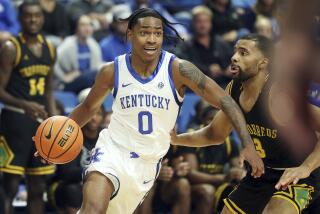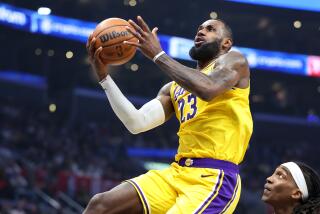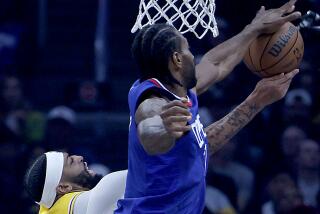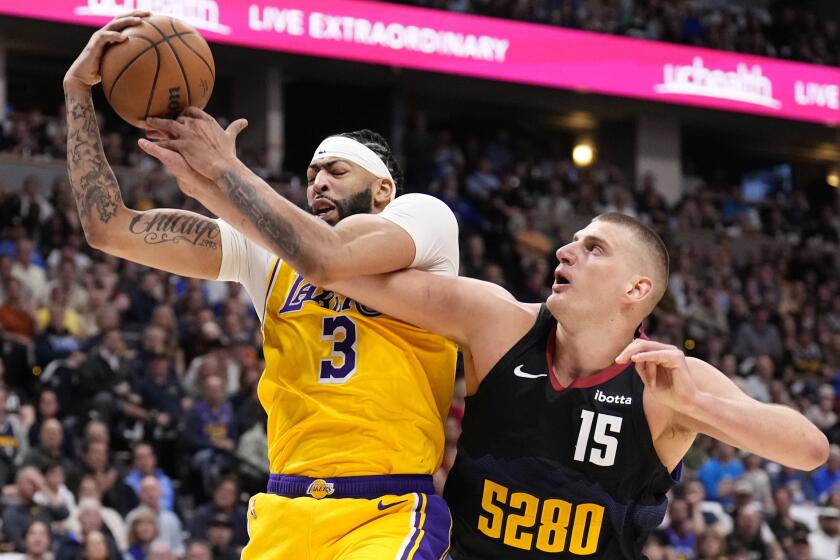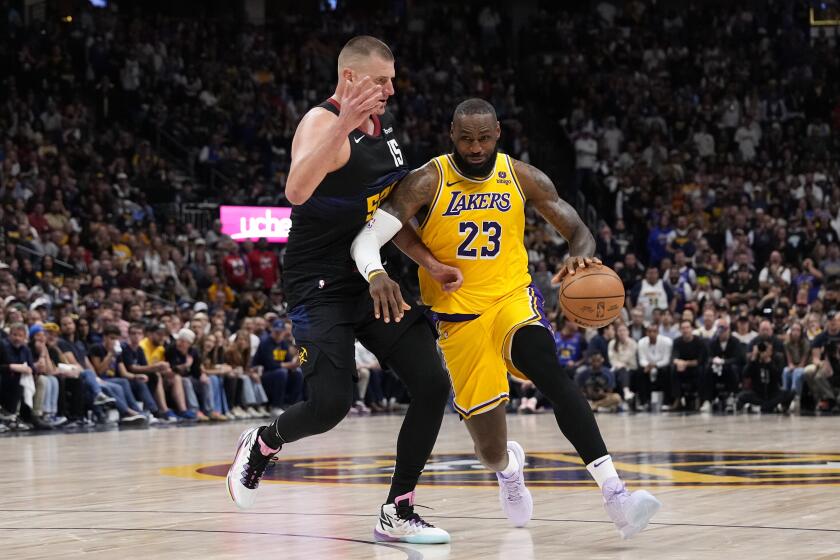Lakers hope lottery balls bounce their way
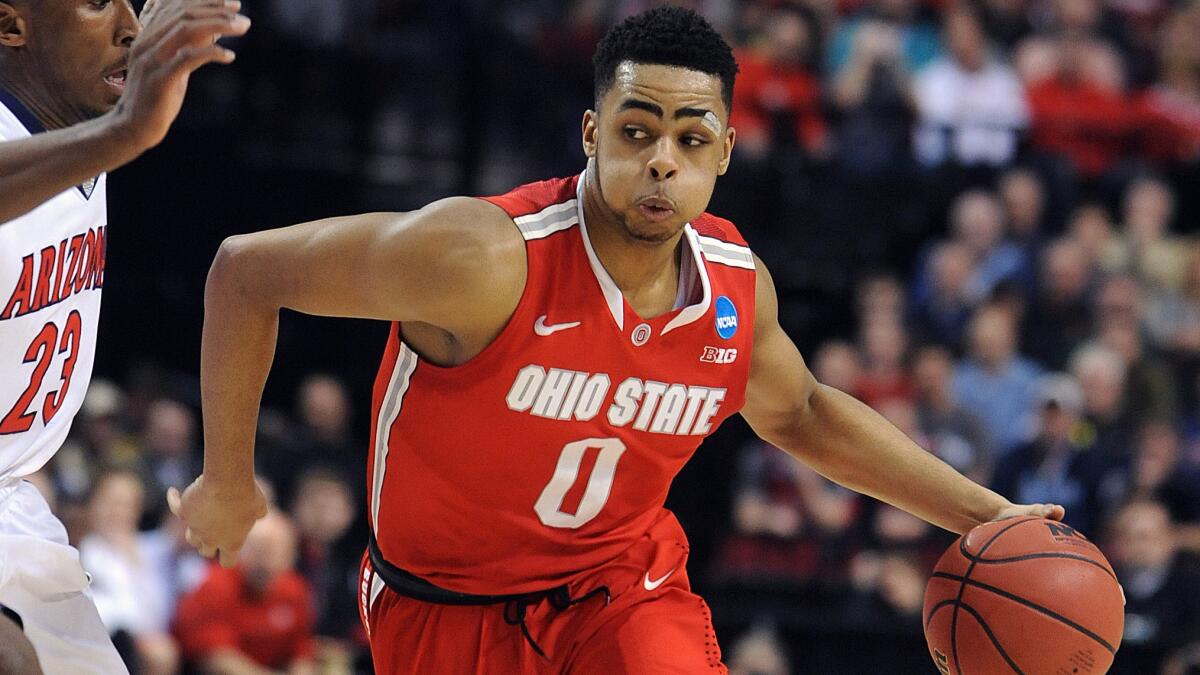
Ohio State point guard D’Angelo Russell drives to the basket during a loss to Arizona in the NCAA tournament on March 21, 2015. Russell is considered one of the top point guards available in this year’s NBA draft.
Stroll through the Clippers’ sleek practice facility, and there it is, proudly displayed in a hallway near the practice court, the digits that helped turn around their franchise: 5-3-6-10.
They are black numbers on four white ping-pong balls drawn from the 2009 NBA draft lottery that gave the Clippers the No. 1 pick that year and, ultimately, Blake Griffin.
No strangers to past lotteries, the Clippers are on to better things these days, although 14 teams, including the Lakers, will be tucked into a pair of large rooms in a New York hotel Tuesday to determine the official draft order in June.
Once upon a time, draft position was based solely on a team’s regular-season record with one quirk: The worst team from each conference took part in a coin flip to determine who got the actual No. 1 pick.
Entering its 30th year, the NBA lottery has evolved into a dramatic half-hour show, with poker-faced Hall of Famers, smiling daughters of team owners and tense general managers awaiting the opening of stuffed envelopes that determine their draft position.
“It’s great theater,” said Orlando Magic executive Pat Williams, the most successful participant in lottery history with three winning nights. “It’s a dramatic evening, particularly if there is an absolutely great player in the draft.”
There isn’t a LeBron James or Kevin Durant in this draft, but scouts say there are two potential star big men — Duke’s Jahlil Okafor and Kentucky’s Karl-Anthony Towns — and two at point guard — D’Angelo Russell of Ohio State and Emmanuel Mudiay, who played professionally in China instead of attending Southern Methodist.
The Lakers can only hope to capture some of Orlando’s luck after finishing with a 21-61 record, the worst season in the franchise’s 67-year existence. Their immediate fortune will now be reduced to chance and fate.
On lottery night, ping-pong balls are numbered 1 through 14 and placed in a plastic drum manufactured by Smartplay International, a top provider of state lottery machines.
When four balls are drawn out of 14, there are 1,001 possible combinations. Before the lottery begins, 1,000 combinations are assigned to participating teams based on their regular-season record.
Minnesota had the NBA’s worst record and will hold 250 of those combinations, giving the Timberwolves a 25% chance of winning the No. 1 pick. New York will have 199 combinations and a 19.9% chance at the top pick; Philadelphia (15.6%) and the Lakers (11.9%) are next, followed in descending order of probability by 10 more teams.
Once the 14 balls are loaded into the hopper, they are mixed via air current for 20 seconds and individually drawn four times to the top of the hopper to determine a four-digit combination. The team assigned that combination receives the No. 1 pick.
The four balls are placed back in the drum and the process is repeated for the No. 2 and No. 3 selection. That will be all. If the same team is drawn more than once, the result is discarded and another four-ball combination is selected. If the lone unassigned combination is drawn, there will be a redraw for that pick.
The closed drawing takes place in a hotel conference room with a representative from all 14 teams in attendance, along with NBA executives, delegates from accounting firm Ernst & Young and a handful of media members. It takes place more than an hour before the start of the more dramatic TV broadcast in a nearby ballroom that features 14 other team representatives, none of whom know the results that have been placed into individual envelopes and arranged accordingly to be read aloud from 14th to first by NBA Deputy Commissioner Mark Tatum.
Everybody in the first room is barred from leaving it until the TV broadcast is complete. Cellphones, computers and other devices are temporarily confiscated from witnesses of the drawing to ensure results are not leaked before the TV broadcast.
The team with the highest percentage to secure the No. 1 pick has won the lottery only three times in the last 21 years, creating plenty of surprises on lottery night. Cleveland jumped from ninth to first last year with the combination of 13-7-9-14, while bucking a 1.7% chance of getting the top pick.
Cleveland’s unexpected move created a ripple effect for several teams, including the Lakers, who dropped from No. 6 to No. 7.
Team publicist John Black will witness the drawing for the Lakers, while Coach Byron Scott will be their representative for the TV show.
Black was in the drawing room last year and remembers the tension.
“It was interesting, but it was a little bit frustrating, having dropped down a notch and knowing that the rest of our organization — our GM, our owners and everyone else — didn’t know,” Black said. “Your human inclination is wanting to share that information with them. There’s that weird time lapse of sitting in that room, being sequestered and just waiting.”
Then again, Black agreed to do it again Tuesday.
“It shows you what I’ll be willing to go through,” he said. “I’m a glutton for the great restaurants New York has to offer.”
The Lakers have the added intrigue of losing their pick if two teams pass them in the lottery, of which there is a 17.2% chance. They would have to forfeit the pick as part of the Steve Nash trade because it was only top-five protected when the deal was consummated in 2012.
There is, however, a 37.8% chance the Lakers land one of the top three picks.
None of these percentages were in play during the earlier days of the NBA. From 1966 to 1984, a coin flip determined which team would draft first, something that benefited the Lakers in 1982. They owned Cleveland’s first-round pick because of a trade involving Don Ford and Butch Lee, and then won the coin flip against the San Diego Clippers for the right to select future Hall of Famer James Worthy.
But the NBA board of governors voted to adopt a lottery system for the 1985 draft after Houston “went in the tank,” Orlando’s Williams said, purposely losing a lot of games and ending up with Hakeem Olajuwon with the top pick in the 1984 draft.
The first lottery, though, didn’t come without controversy. Seven envelopes were placed into a large plastic hopper and pulled out one at a time until New York ended up with the top pick. Conspiracy fanatics theorized that Commissioner David Stern kept the Knicks’ “frozen envelope” in the hopper until it was the last one remaining, allowing the Knicks to pass smaller-market teams such as Indiana and Golden State and ultimately draft Patrick Ewing.
That incarnation lasted until 1990, when the lottery was increased to 11 teams because of expansion. The team with the worst record received 11 chances at the No. 1 pick (out of a total of 66), the second-worst team had 10 chances and the team with the best record among the non-playoff clubs got only one chance.
The lottery underwent changes in 1996 that closely mirror what it is today, including the move to a 25% chance for the team with the worst record.
“There’s no format that’s perfect, but this is as close as you’re going to get,” Williams said despite an increasing debate about lottery reform in recent years. “I think the league has found the best system at this point.”
There will be recognizable faces among team reps for the TV show, including Russell Westbrook (Oklahoma City), Larry Bird (Indiana) and Alonzo Mourning (Miami). Despite their distinguished on-court careers, however, the bounce of the ping-pong balls will be out of their control.
Orlando, like the Clippers, showcases its winning balls from past lotteries.
“Those little balls have a permanent home here,” Williams said. “It’s a wonderful, cushy life for them if they prevail.”
Twitter: Mike_Bresnahan
More to Read
All things Lakers, all the time.
Get all the Lakers news you need in Dan Woike's weekly newsletter.
You may occasionally receive promotional content from the Los Angeles Times.
